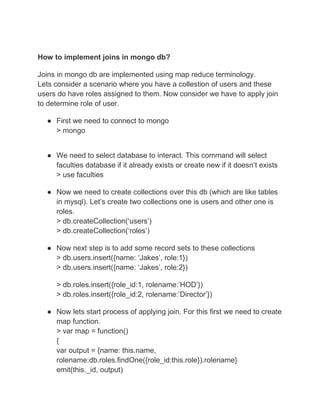How to implement joins in mongo db
- 1. How to implement joins in mongo db? Joins in mongo db are implemented using map reduce terminology. Lets consider a scenario where you have a collestion of users and these users do have roles assigned to them. Now consider we have to apply join to determine role of user. ŌŚÅ First we need to connect to mongo > mongo ŌŚÅ We need to select database to interact. This command will select faculties database if it already exists or create new if it doesnŌĆÖt exists > use faculties ŌŚÅ Now we need to create collections over this db (which are like tables in mysql). LetŌĆÖs create two collections one is users and other one is roles. > db.createCollection(ŌĆśusersŌĆÖ) > db.createCollection(ŌĆśrolesŌĆÖ) ŌŚÅ Now next step is to add some record sets to these collections > db.users.insert({name: ŌĆśJakesŌĆÖ, role:1}) > db.users.insert({name: ŌĆśJakesŌĆÖ, role:2}) > db.roles.insert({role_id:1, rolename:ŌĆÖHODŌĆÖ}) > db.roles.insert({role_id:2, rolename:ŌĆÖDirectorŌĆÖ}) ŌŚÅ Now lets start process of applying join. For this first we need to create map function. > var map = function() { var output = {name: this.name, rolename:db.roles.findOne({role_id:this.role}).rolename} emit(this._id, output)
- 2. }; ŌŚÅ Now time to create map function > var reduce = { function(key, values) { var outs = {name:null, rolename:null} values.forEach(function(v) { if(outs.name == null) { outs.name = v.name } if(outs.rolename == null) {outs.rolename = v.rolename } }); return outs; }; ŌŚÅ Now time to apply map reduce over the collection to be joined. > db.users.mapReduce(map,reduce,{out:ŌĆÖresult_collŌĆÖ}) ŌŚÅ Now result of join will be stored in result_coll, to check the output you can query result_coll. > db.result_coll.find() [Thanks for reading] ---------------------------------------------------------------------------------------------------------------------- Author: Prasoon Sharma Email: Prasoon.sharma1983@gmail.com


![};
ŌŚÅ Now time to create map function
> var reduce = { function(key, values) {
var outs = {name:null, rolename:null}
values.forEach(function(v) {
if(outs.name == null) { outs.name = v.name }
if(outs.rolename == null) {outs.rolename = v.rolename }
});
return outs;
};
ŌŚÅ Now time to apply map reduce over the collection to be joined.
> db.users.mapReduce(map,reduce,{out:ŌĆÖresult_collŌĆÖ})
ŌŚÅ Now result of join will be stored in result_coll, to check the output you
can query result_coll.
> db.result_coll.find()
[Thanks for reading]
----------------------------------------------------------------------------------------------------------------------
Author: Prasoon Sharma
Email: Prasoon.sharma1983@gmail.com](https://image.slidesharecdn.com/howtoimplementjoinsinmongodb-140721075823-phpapp01/85/How-to-implement-joins-in-mongo-db-2-320.jpg)